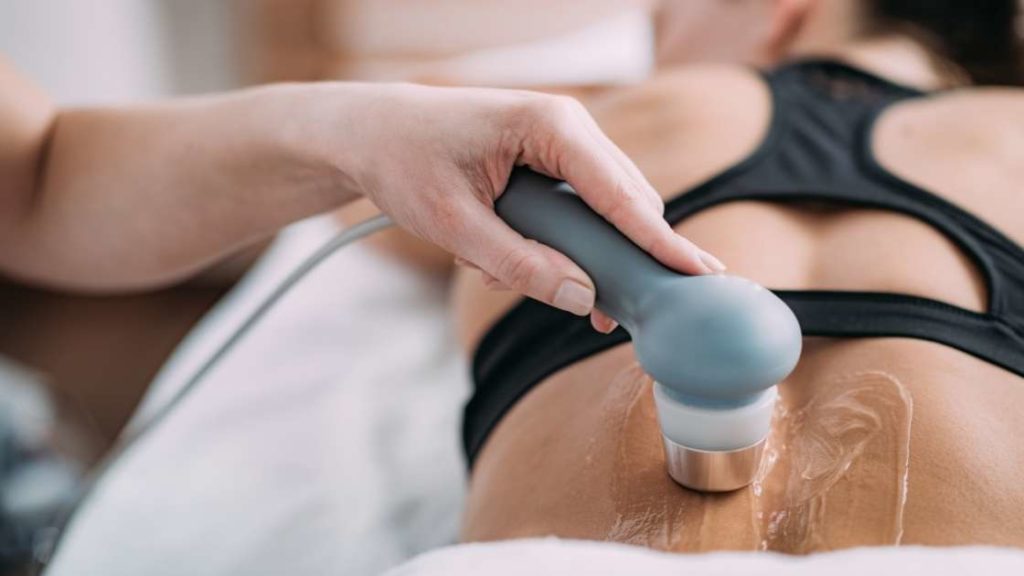Ultrasound Therapy: How Does it Work and Who is it For?

Muscle pain, bone pain, ligament pain, tendon pain, nerve pain… musculoskeletal pain is just as abhorrent as it is common.
Knowing how common it is, my guess is that you have some degree of musculoskeletal pain right now. And if you don’t, you probably will eventually, since you’re likely slouching forward as you read this. Now sit up straight before the pain sneaks further into your neck!
Anyway, you’re in pain and looking for a quick and/or relaxing treatment. But the massage therapists are fully booked for the day, and you’re not crazy about the sudden movements of chiropractic adjustments. That’s when I show up to tell you that not all physiotherapy modalities are abrupt and crackly!
Are you familiar with ultrasound therapy? It’s a procedure, often used by chiropractors and physical therapists, that uses sound waves to promote tissue healing and circulation. While the benefits have been accepted since the 1950’s, how exactly does ultrasound therapy work? And what conditions is it shown to effectively treat?
How Does it Work?
This is an ultrasound machine.
When an ultrasonic machine is applied to the skin, the mechanical vibrations send sound waves to the soft tissues below. The machine has custom settings to target superficial or deep structures in the body, and the sound waves can be delivered continuously or in short bursts. For the treatment of deep soft tissue, the ultrasound will be most effective on a low frequency setting (1 MHz, or 1 megahertz, or 1 million cycles per second.) For the treatment of more superficial structures, the ultrasound will be set to a high frequency setting (3 MHz, or 3 million cycles per second. That’s a lot of cycles!)
The heat created by vibrations will relax the injured tissue and send blood flowing to the area, which will in turn relieve pain and speed up recovery.
Who Benefits from Ultrasound Therapy?
Anyone with musculoskeletal discomfort, as I mentioned previously, can benefit from ultrasound therapy. The treatment is predominantly sought for muscle, bone, ligament, tendon, and nerve pain. Feeling sore from a long workout? Working too many hours at a desk? If activities of daily living are stressing your body, see how an ultrasound machine treats them. Let the heat and vibrations go to town on that tightness!
But more specifically, what conditions can really benefit from ultrasound therapy? It has been shown to effectively treat scar tissue and inflammation that arise from the following conditions:
- Tendinitis
- Bursitis
- Osteoarthritis
- Carpal tunnel syndrome
- Sprains and strains
- Post-surgery pain
- Cancer*
-
- While high frequency ultrasound therapy has been used to kill cancer cells in certain types of cancer, it isn’t suitable for all types of cancer. High frequency sound waves don’t pass through solid bone, making it ineffective for cancer that has spread to the bones. It can even be harmful, as high frequency ultrasound may attack normal cells if it can’t reach the cancer cells.
-
Is it Right for You?
If you’re a member or a first time patient, schedule a free consultation with one of our chiropractors.
As always, stay happy and healthy!
Katrina Jenkins
Author, Licensed Massage Therapist
Katrina Jenkins graduated from Towson University in 2013 with a Bachelor’s Degree in Health Science and worked as a nurse’s aide briefly before pursuing her true passion. She graduated from the Massage Therapy Institute of Colorado in April 2016 with honors and completed the Touch of Healers Scholarship Program the following summer. She has been a part of the Moyer Total Wellness Team since the summer of 2017.
Resources
“High Intensity Focused Ultrasound | Other Treatments | Cancer Research UK.” Www.Cancerresearchuk.org, 13 Aug. 2018, www.cancerresearchuk.org/about-cancer/cancer-in-general/treatment/other/high-intensity-focused-ultrasound-hifu#:~:text=High%20intensity%20focused%20ultrasound%20(HIFU)%20is%20a%20treatment%20that%20aims. Accessed 3 Dec. 2020.
Miller, Douglas L., et al. “Overview of Therapeutic Ultrasound Applications and Safety Considerations.” Journal of Ultrasound in Medicine, vol. 31, no. 4, Apr. 2012, pp. 623–634, 10.7863/jum.2012.31.4.623.
“Ultrasound Therapy.” Physiopedia, www.physio-pedia.com/Ultrasound_therapy.
Photo Credit
Canva by microgen from Getty Images
Canva by frantic00 from Getty Images
